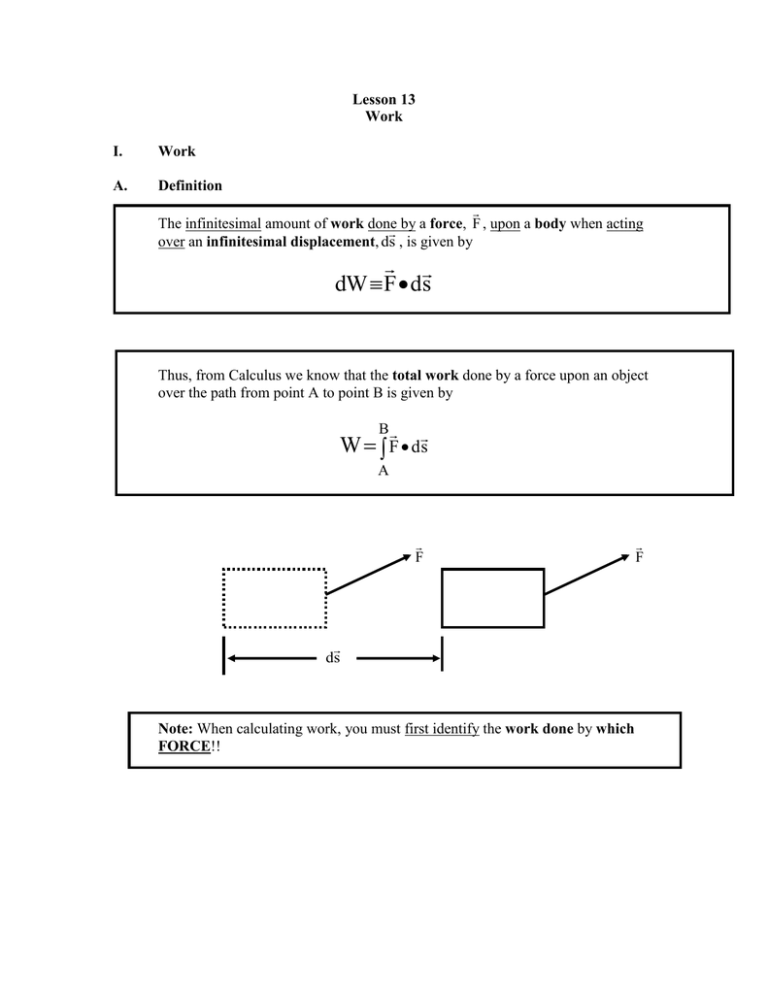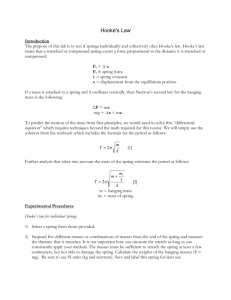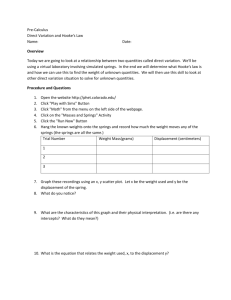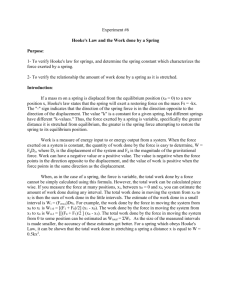s
advertisement

Lesson 13 Work I. Work A. Definition The infinitesimal amount of work done by a force, F , upon a body when acting over an infinitesimal displacement, ds , is given by dW F d s Thus, from Calculus we know that the total work done by a force upon an object over the path from point A to point B is given by B W F ds A F ds Note: When calculating work, you must first identify the work done by which FORCE!! F B. Special Cases: If we look at the integrand we see that if the ___________________ between the ____________________ and _______________________ is ___________________ and if the __________________________ of the _______________________ is ________________________ then the definition of work is simply C. Important Facts About Work 1. The work done by a force is _________________ if any of these four cases hold: a) The force is __________________________. b) The displacement is _______________________. c) The force is __________________________ to the displacement. d) The integral (AREA under a force-distance graph) is ________________ Example: The work done by Earth's gravity on the moon assuming that the moon travels in a circular orbit. v Earth The force is NOT Zero The displacement is NOT Zero The work is __________________________________ 2. Work is a _____________________________ . Thus, the net work on an object (ie the work by the net external force) is just 3. The unit of work is ____________________________ . We don't use ____________ because another quantity, TORQUE, also has these units. Example 1: Calculate the work done by the 5.0 N force as the block is moved 5 m up an inclined plane with 40 degree inclination as shown below: F=5N 40 Solution: Example 2: What is the work done by gravity on a ball as it falls a vertical distance h? Example 3: What is the work done by gravity on a ball as it rises vertically by a distance h? Let Us Solve Example 3 Using Calculus: Evaluate Integral Analytically OR Graphically II. Hooke Springs A. Hooke's Law The magnitude of the restoring force on an ideal spring is ___________________ _____________________ to the ____________________ the spring is ___________________ from its un-stretched position. The direction of the spring force opposes the direction of ___________________ or ______________________. x=0 Un-stretched Position Magnitude: Direction: x=0 x Stretched Position B. Spring Constant The spring constant contains ALL ___________________________ about how the spring was ___________________ . Big k small k C. means a ________________________ spring. means a ___________________________________ spring. Are real springs actually Hooke Springs? ______________ If the __________________ or ____________________ is _________________! Math Reason: Any analytical function f (x), ie smooth, finite function, can be represented as a power series expansion about some point xo. This is known as a Taylor series expansion and the formula is f(x x 0 ) A 0 A1 (x x 0 ) A 2 (x x 0 ) 2 A 3 (x x 0 ) 3 ..... where the coefficients are found by the formula An dnf dx n x x0 If the difference (x-x0) is very small then only the first few terms are needed to approximate the function. Expanding the force of the spring around the un-stretched position x0 = 0, A0 is zero so the first non-zero term is A1x. The coefficient A1 is our spring constant k! The higher order terms are called anharmicity terms for springs and are related to thermal expansion properties when using spring forces to represent the binding of atoms in a solid. Homework Problems: The Taylor expansion is very useful for making calculations with a computer as well as for modeling real systems in physics and engineering. A) Derive the Taylor series expansions for Cos(x) and Sin(x). B) What are the small angle approximations for these functions? C) Why are these small angle approximations only valid if the angle is measured in radians and not degrees? Hint: Perform dimensional analysis on the Taylor series and then look up the definitions of degrees and radians. D. Work Done By A Hooke Spring (Example of Calculating Work For NonConstant Forces) Let us use Calculus to determine the work by a spring upon the mass as it is stretched a distance X from its un-stretched position. Graphically III. Types of Work We divide work into two basic types based upon whether the amount of work done depends upon the path that the object takes or only upon its starting and ending point!! A. If the __________________ done by a force upon an object only depends on the objects ___________________ and __________________ location and _________________ upon the ___________________ then the force is ___________________________ . B. All other forces are __________________________________________ . C. The work done over a ________________________ path by a _________________________ force is always ______________________. D. If the curl of a force is ______________________ then the force is _________________________ . Problem: Prove that gravity is a conservative force. IV. Work VS Force Calculations Since Newton's Laws tell us everything about mechanics, why do we want to develop new concepts? First, the concept of work will simplify the math necessary to perform calculations for more complex problems. Second, the concept of energy and work will work on problems where Newton's Laws do not apply (Quantum Mechanics, etc). EXAMPLE: Let us assume that we want to determine the speed of an object at some instant of time. Math Difficulty #1: We know that from Newton II that a Force causes a particle to accelerate. If we then want to find the speed of the particle, we would need to integrate the acceleration with respect to time. Only in the special case of constant acceleration can we use the kinematic equations to avoid integration. Work will often enable us to go directly to speed without doing an integral. Math Difficulty #2: Forces are vectors while work is a scalar!! Scalar math is much easier than vector math! Math Difficulty #3: We may not know the form of a particular force. However, if we can determine that the force does no work then we don't care! Final Solution: Bring together our concepts on work with the concepts of mechanical energy, kinetic energy, and potential energy in next lesson so that we can find the speed without integrals or vector math.




